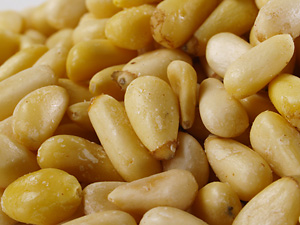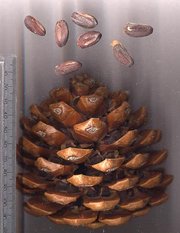Pine nuts are the seeds of pine trees and have been used as a food source by Native Americans for thousands of years. Processing the nuts is labor intensive but the nutritional value is very high. Pine nuts have a high potential to become important in the US economy if domestic resources are developed. ECOLOGY Pine nuts are the edible seeds/nuts found within the cones of 20 different species of pine tree, of which there are five main commercial species. The most commonly gathered pine nuts in North America are from the pinyon (pinon) or single leaf pinyon pine tree, Pinus monophylla. Pinyon pines grow on the grasslands and chaparral covered hillsides and foothills of the Sierra Nevada, the coast range of California, the Great Basin and the Rocky Mountains and south to Mexico, ranging in elevation of 5,000-12,000 feet (Kroeber 1961). They can grow in a variety of soils from wet clay to sandy loam along with neighboring juniper, Manzanita and blue oak. The tree itself reaches heights of 15-20 ft tall with a low, spreading branching pattern (Kroeber 1961). The cones are about 5-8cm long containing 10-20 seeds each. These nuts are noted for their large size and sweet taste (Shufer 2004). A large seed crop is produced every 1-2 years; they can begin producing at 8 years and for the rest of their lifespan which can last well beyond 150 years (Farris 1982). The cones are harvested in late summer until early winter.
|
|
| HISTORY
Many Native American cultures gathered the pine nuts of their specific range and used them for many aspects of their cultural life. These uses varied from a main staple food source to dried seed beads to medicinal salves for the body. The Washo, Shoshone, Paiutes and Hopi gathered in the Great Basin for 10,000 years as a main source of food and for use in creation stories, celebrations and teachings (Savinelli 1997). They would harvest in the late summer or fall in the intermediate elevation pinyon and juniper forests and continue until winter. The people knew it was time to harvest when the rabbit brush flowers turned yellow, signaling the ripening of the pine nuts (Krober 1961).
|
 |
| ECONOMICS
There are five commercially important nut producing species including the Siberian pine (Pinus sibirica), Korean pine (Pinus koraniensis), Italian stone pine (Pinus pinea), Chilgoza pine (Pinus geradrdiana), Single leaf pinyon (Pinus monophylla) and the Colorado pinyon (Pinus edulis). As a finished market product the kernels are usually not distinguished by species. Various commodities are made from this nut including oil which can be used as a gourmet food or massage oil or included in beauty products and cosmetics. This specialty oil can also be encapsulated and sold as internal medicine. The oil-press byproducts, nut flakes, are included in granola, crunch bars and chocolates. This can also be used to make a flour alternative and be baked into gourmet pastries (Sharashkin 2004).
|
|
|
|
The Single leaf pinyon pine nut or Indian nut, as it is sometimes called, is gathered for commercial sale in the American southwest. These trees are part of a forest ecosystem instead of mono-crop plantations where most of the imported nuts are grown. Pinyon nuts can be purchased at local specialty food shops or ordered off the internet from a few companies that ship to their customers. Pine nuts are sold in the cone, in the shell (raw or roasted) and pre-shelled (raw or roasted). The typical plantation, imported pine nut is shelled and preserved which decreases the flavor. Most pinyon nuts are sold fresh in the shell and require home roasting to enhance the flavor. |
| POLICY AND MANAGEMENT
The US should be able to provide much more of the global supply of pine nuts by growing pinyons domestically. Management of existing pinyon-juniper forests for pine nuts, along with exploring agro forestry for either native or exotic nut producing species, could increase the US production. Unfortunately much of the Great Basin pinyon forest was cut for charcoal production and cleared for pasture despite the fact that the monetary and nutritional value of pine nuts is far higher than that of cattle. Pinyon nuts are 28 times more “Earth efficient” in terms of protein production per acre than beef. Four million acres of mature, seed producing pinyon forest was converted to cattle pasture in the years from 1965-1973, with little to no scientific research done to assess impacts (Frazier 2004). Unfortunately there are large corporate interests in the use of public lands and often timber, cattle and mining industries can set the priority for policy (Frazier 2004). Cattle grazing is well established in this system of public lands use and creates a profit for the district. Policies have been created which support cutting pinyon forests based on unsupported claims of fire safety and pinyon invasion of grasslands. Neither of these premises is supported by any scientific evidence. Pinyons cannot establish themselves successfully in grassland areas because they need moisture and shade. They are also fire resistant and the pasture grass is far more flammable than the trees themselves so cutting trees does not decrease the fuel load (Frazier 2004).
*Compiled from a paper by Michelle Hansen |
|

